The 500-odd farmers of Gurha Kumawatan, a village in arid Rajasthan, are now millionaires thanks to polyhouse farming. Their hard work, innovation and unlimited ambition offers a path to prosperity for others in India.
MS Swaminathan who helped India fight hunger and revitalize its agriculture is arguably the greatest Indian post-Independence
 TR Vivek
TR Vivek 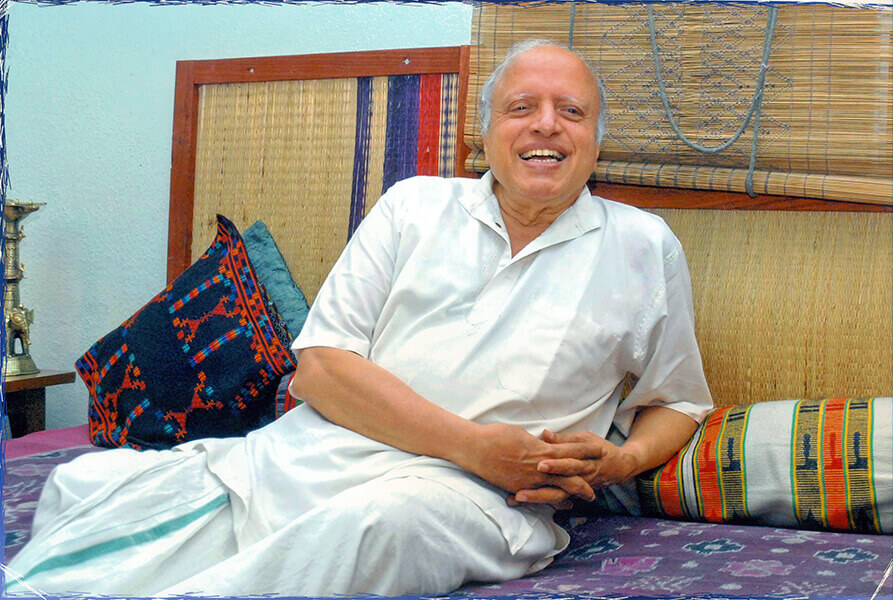
On the occasion of India’s 65th anniversary of Independence, television channels CNN-IBN (now CNN News18), History Channel, and Outlook magazine jointly ran an audience poll, steered by a panel of “experts”, to ascertain the ‘Greatest Indian after Gandhi’.
Mankombu Sambasivan Swaminathan, who passed on at the age of 98 on September 28, 2023, barely made it to a shortlist of 50, let alone the Top 10 that contained Sachin Tendulkar and Lata Mangeshkar in a club overwhelmingly comprising politicians.
Such lists are gimmicks anyway and a result of political partisanship, recency bias and media narratives.
In this writer’s view, with no disrespect to those of yours, there isn’t anyone more worthy of the tag ‘greatest Indian since Independence’ than Dr MS Swaminathan. He provided the bedrock of science and built institutions up from scratch with scant resources to usher in the Green Revolution. His contributions made India not just food self-sufficient, helped 800 million poor escape hunger, but also turned it into a leading producer of every major agricultural commodity.
Faith and food
Swaminathan can be seen as the male embodiment of Annapoorna, a form of Parvati, the Hindu deity of food and nourishment, holding in one hand a Leitz binocular research microscope and his field notes in another, instead of the pot and ladle filled with food in popular religious iconography.
That both the Goddess of nourishment and Swaminathan, the scientific guarantor of food security, are now relegated in public consciousness are a measure of India’s progress and the liberty we now have to take access to food for granted.
Hungry nation
To understand the importance of Swaminathan’s work, it is instructive to survey the first twenty five years of Independent India’s history.
By 1962, India was a basket case; the doomsayer’s dream come true; a nation humiliated on the battlefield and stripped of its self-esteem, living on Western food-aid.
During the disastrous war with China in 1962, Prime Minister Nehru’s letter to US President John F Kennedy seeking help to ensure the very “survival of India ” wasn’t forwarded for a week because of its “naked desperation”. In any case the US didn’t respond because it was preoccupied with the Soviet Union planning to deploy nuclear missiles closer home in Cuba.
The Bengal famine of 1943 which starved 3.5 million Indians to death had a profound impact not just on the freedom movement but also in the politics and the policy course of free India.
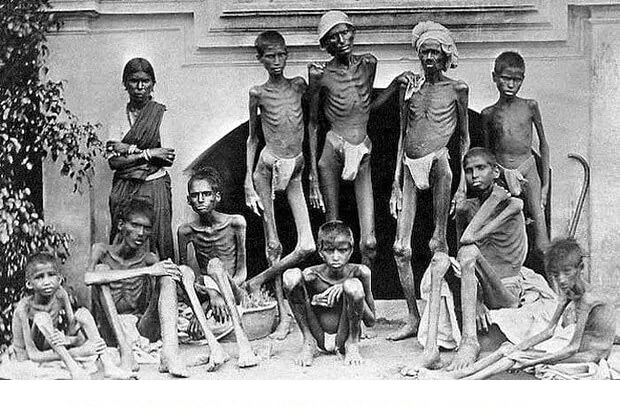
“After decades of marches, boycotts, and strikes in protest of the economic consequences of imperial rule, the Bengal famine marked, in Jawaharlal Nehru’s words, ‘the final judgement on British rule in India.’ As India’s citizens and politicians reflected upon the famine, they saw in it the clearest failure of colonial politics and economics, tying the promise of self- rule to the project of sustenance for every Indian. Famine had long been central to Indian understandings of imperial injustice, but after 1943, the elimination of hunger emerged as a nationalist imperative,” writes Benjamin Seigel, a Boston University historian of politics, agriculture, and the environment, in his 2018 book Hungry Nation.
Farm versus factory
But stagnant agriculture and a crippled industry meant the python-grip of hunger only got tighter in the two decades post-Independence.
The economic model India pursued under Nehru’s leadership involved top-down industrialization. The government through the companies it owned would make steel, electricity and the heavy machinery needed to create ‘New India’. The only way to fund all of this was to suck agriculture dry. Nearly 90% of the country’s population was agrarian and farming drove most of the economic activity.
“Borrowing large sums from abroad was out of the question—India didn’t have the stores of foreign exchange that would be necessary to repay the loans. Funds for industrialization therefore had to come from India itself. Creating an industrial economy thus implied skimming off the profits from rural peasants and using that money to build steel mills, power plants, and highways in urban areas. Like [Mahatma] Gandhi, Nehru was sympathetic to the plight of poor farmers. Nonetheless, his ideas about development unavoidably led him to drain the agricultural countryside to benefit the industrial cities,” writes Charles Mann, a US journalist and science writer in his book The Wizard and The Prophet that looks at the lives of scientists Norman Borlaug and William Vogt, the greatest 20th century influences on agricultural science and environmentalism respectively.
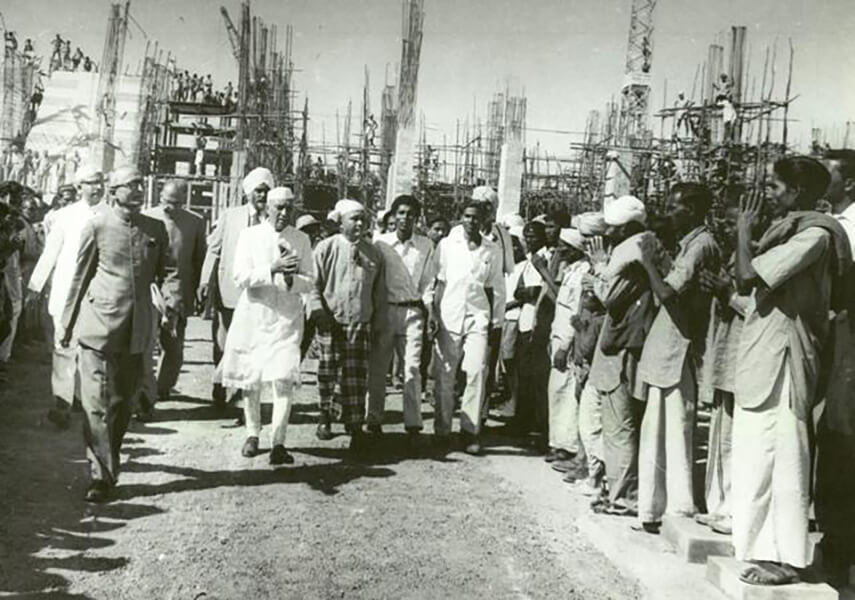
Begging bowl
This policy resulted in abject underinvestment in agriculture. The government-led heavy industry plan too was built on a shaky foundation in the absence of a small and medium industrial base of private entrepreneurship.
As early as 1950, India had to approach the US for 2 million tonnes of grain in desperate food aid. The request was a significant turning point not just for India. The US realized the power of such aid. It was soon packaged as the ‘food for peace’ programme– a potent Cold War weapon to prevent newly independent countries such as India joining the Soviet camp.
In 1954, US passed a law popularly known as PL480 that allowed the American government to dispose its surplus grain abroad at highly subsidized rates.
Hot meal in Cold War
In one stroke, the US could get rid of surplus food and keep domestic farm prices stable, while using the excess as part of the global policy to contain communism. Between 1956 when India signed a deal with the US under the PL 480 plan, up to 1970, it received nearly 65 million tonnes of cheap wheat (almost half of India’s current annual production). India paid for PL 480 grain in rupees, held by the American government in India. The money was to be spent in the country in the form of development investments. By the 1970, it is estimated that PL 480 payments gave the US control of as much as one-third of India’s total money supply.
“It was almost as if the Americans had bought a big piece of India with grain,” wrote John F Perkins, a scientist and historian in the book Geopolitics and the Green Revolution.
The addiction to cheap American wheat was so big and the incentive to increase domestic farm production so little that the average wheat yields of about 700-900 kg per hectare until 1965 was no different from the time of the Mughal empire in the 16th century.
Cheap imported wheat allowed the government to open a bread-making business under the brand Modern Foods (now owned by Unilever India) to keep up with urban food demand.
Today, India is among the world’s largest producers of every major agricultural commodity including rice, wheat, cotton, sugar and fruits and vegetables. Despite the Covid-19 lockdown, and the disruption of global trade due to the war in Ukraine, India remains relatively hunger free and food self-sufficient.
We have to thank MS Swaminathan, the principal architect of India’s Green Revolution and for his pivotal role in upending the paradigm of penury in the country.
Famine warrior
Swaminathan was born in 1925, in Kumbakonam, to parents committed to India’s freedom movement. His father was a medical doctor who set up practice in the heart of the Kaveri delta, far away from the ancestral home in Mankombu, a village in the lowlands of Kerala’s southern coast. Swaminathan’s father Sadasivan was devoted to helping fight the mosquito-transmitted disease called filariasis that made human legs swell so much to resemble an elephant’s.
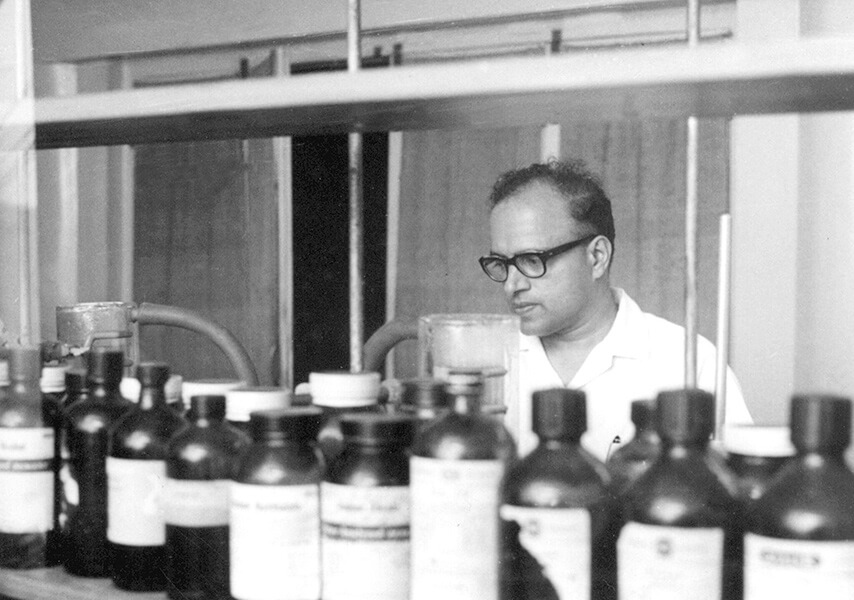
“He mobilized school children to identify mosquito breeding grounds, then asked their parents to fill in stagnant pools and move garbage dumps and disinfect drains and sewers. New cases of the disease ceased to occur—a lesson, Swaminathan said later, in the power of collective action,” writes Charles Mann.
Swaminathan wanted to become a doctor like his father, but the horrific stories of famine deaths in Bengal steeled his resolve to help India find a way out of hunger. After a bachelor’s degree in botany at Thiruvanthapuram’s University College (a prerequisite course for pursuing medicine) Swaminathan enrolled into another bachelor’s course at the Coimbatore Agriculture College. There he graduated at the top of his class, and won almost every award on offer. A postgraduate research scholarship to study at the Indian Agricultural Research Institute (IARI) in New Delhi followed. Swaminathan’s task there was to work on the solanaceae, a family of plants that includes tomatoes, potatoes, chillies and brinjal. In the meantime, at the prodding of relatives who were convinced that it was impossible to make a career in agri sciences, he had also passed the civil services examination in 1949. His rank allowed him to join the Indian Police Service (IPS), and he almost became a police officer. Luckily, for India and Swaminathan, he won a UNESCO fellowship at around the same time to study at Wageningen University, the Dutch national agricultural school.
“The Netherlands was just recovering from the war; famine of 1944–45 was a fresh memory. The university labs lacked heat and sometimes electricity. Swaminathan was asked to switch from brinjals to potatoes, a Dutch staple. Dutch potato fields were aswarm with parasitic nematodes. Wageningen was trying to fight them by breeding domesticated potatoes to wild, nematode-resistant relatives. But the wild and domesticated species had different numbers of chromosomes, which usually makes successful breeding impossible. Swaminathan figured out a workaround. The discovery was valuable enough to bring him to Cambridge University, in England, where he finished his PhD,” writes Mann.
A new breed
Swaminathan became one of the global pioneers in plant cytogenetics, a field of study on how chromosomes and their genetic information impact plant traits, breeding, and evolution.
Cambridge offered him a teaching position after he finished his dissertation, but he chose to join the University of Wisconsin as a postdoctoral fellow. The university at that time had the largest collection of Solanaceae plant family germplasm.
Germplasm is like a treasure chest of seeds, tissues, or cells that contains the genetic information needed to grow new plants.
Swaminathan’s rise at Wisconsin was swift. “Quick, affable, crisply logical, able to juggle multiple lines of inquiry at once, he had a knack for splitting difficult problems into manageable chunks that were each susceptible to the knives of scientific inquiry. His experiments just worked. Articles issued from Swaminathan’s typewriter in an orderly flow and appeared in major journals. Believing that he was destined for a brilliant career, Wisconsin offered him a position as a professor. He turned down the offer, returning to India in 1954 to help his new country,” writes Charles Mann.
Patriotic purpose
Swaminathan never lost track of the purpose of his pursuit of a career in agri science. “Why did I study genetics abroad? It was to produce enough food in India. So, I came back,” he told his biographer RD Iyer.
Agricultural research assignments to match Swaminathan’s stature were almost non-existent in India. He could only be accommodated in a temporary position as assistant botanist at the Central Rice Research Institute in Cuttack—a colonial era institution. There Swaminathan and his team worked on crossing sticky, short-grained Japanese rice, with Indian varieties that were fluffier. That in part led to the creation of India’s most popular rice even today called Sona-Masuri (an Indo-Japanese hybrid extensively trialled at a place called Mahsuri in Malaysia). Soon, Swaminathan was transferred to Delhi to work on wheat.
“Indian farmers had been working with wheat from the Stone Age gradually creating varieties that were suited to the nation’s climate and its culinary preference for the kind of amber-coloured, hard-grain wheat that makes the thin, light-coloured, puffy flatbread called chapati or roti. Like their Mexican counterparts, Indian farmers grew a scatter of different varieties in their fields, planting them sparsely to deter rust [a fungal disease common in crops such as wheat, barley and rye]. At IARI, Swaminathan quickly discovered that these varieties responded to fertilizer so heartily that they lodged—the same problem faced by Borlaug a few years before,” writes Mann.
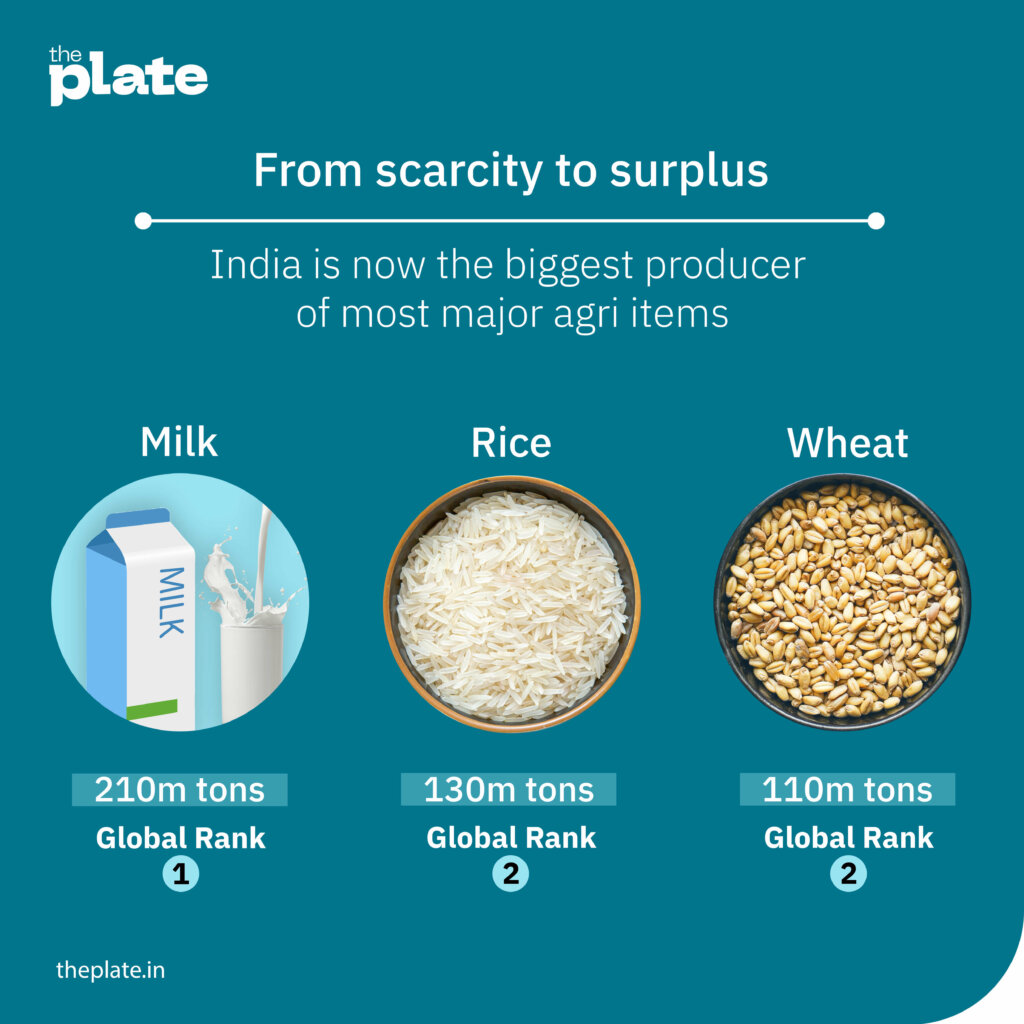
Now, ‘lodging’ is a phenomenon where plants become so productive that their stalks can’t support the weight of their own grains and get knocked down by wind or rain. It’s like a group of tall, skinny people who try to carry massive backpacks but end up toppling over because of the weight. The grain crops had to be shorter, with a stronger stem.
Kindred spirits
Norman Borlaug was born eleven years before Swaminathan in a poor corn-growing family in Iowa, US. His family had to work so hard as to harvest and shuck 250,000 ears of corn by hand every year. Borlaug, by the standards of boys in his community, was lucky to attend even high school. He earned a PhD in plant pathology and genetics, and like Swaminathan, was driven by the desire to lift people out of poverty.
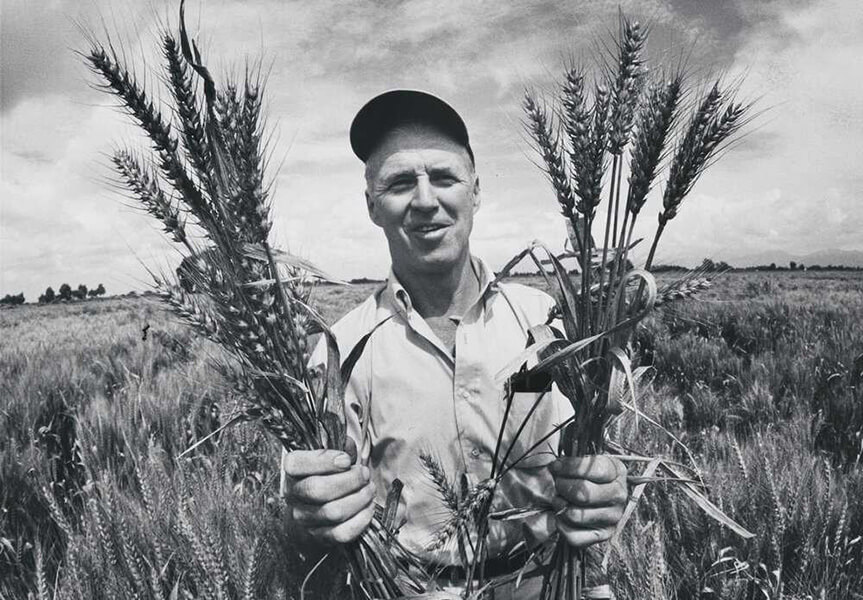
By a series of accidents, he ended up right after WW2 working in Mexico, on a program established by the Rockefeller Foundation to focus on improving corn production. Like Swaminathan, he had no track record of working on wheat, but was put in charge of it. He embarked on a massive breeding program all by himself, crossing thousands of different varieties of wheat, exposing them to various diseases including the most troublesome–stem rust–and picked the ones that survived. Through this toil of a decade, he created a kind of a super wheat that was not only resistant to stem rust, but also five times more productive than other common varieties.
Like Borlaug, the father of the Green Revolution, Swaminathan, its architect in India was pretty much solving the same problem at around the same time in the mid-1950s with far lesser resources. They weren’t even aware of the similar experiments taking place simultaneously across the world, let alone being personally acquainted.
“In 1955 Swaminathan and his IARI collaborators began taking wheat grain to a small particle accelerator at the Tata Institute in Mumbai. The accelerator sprayed out a beam of neutrons, which slammed into a target and produced gamma rays: ultra-high-energy photons. The researchers blasted wheat kernels with gamma rays for several hours, hoping that the gamma rays would tear into the DNA in the seeds and induce favourable mutations. In twenty-first-century terms, this was like trying to perform surgery with a chainsaw—a hopelessly crude procedure. In mid-twentieth-century terms, it was the most advanced method available. Most of the resultant plants failed to germinate or died quickly—the gamma rays had smashed up their DNA like wrecking balls. A few showed interesting characteristics, but none were short-strawed, at least that first year. Or the second. Or the third. Because Swaminathan couldn’t get enough financial backing to irradiate and grow seeds in large numbers, the odds of success were especially poor. Like Borlaug in Mexico, he was throwing darts at moving targets. Unlike Borlaug, he could throw only a few darts at a time. Still, he saw no other way to proceed,” writes Mann.
A tough path
With Nature unwilling to reveal Her secrets readily, a dejected Swaminathan showed his experimental plot to the Japanese wheat geneticist, Hitoshi Kihara who was visiting India in 1958. Kihara asked Swaminathan to get some dwarf, short stemmed, bigger grain bearing wheat samples developed by the US breeder Orville Vogel.
Vogel’s wheat was of the winter variety that wouldn’t suit Indian conditions. He in turn asked Swaminathan to approach Boralug, then working in Mexico on wheat that could flourish in tropical India. Swaminathan’s 1958 letter to Borlaug in Mexico City never reached.
In 1960, just when Borlaug was hired by the US food giant United Fruit Company to improve banana productivity in Honduras, he was asked by the UN’s Food and Agriculture Organization (UN-FAO) to join an expert group to survey wheat and barley research in North Africa, the Middle East, and South Asia.
Borlaug was dismayed by the state of agri-science he witnessed everywhere. Most appalling was the approach of Indian wheat breeders who he thought were obsessed with the beauty of the grain rather than increasing yields. The first meeting between Borlaug and Swaminathan was disastrous. “They spoke for about an hour. Neither man seems to have been particularly impressed with the other. One can imagine Swaminathan paying little attention to the blunt, poorly educated foreigner who was trying to tell Indians what to do; Borlaug, for his part, may have seen the other man as the sort of smooth careerist,” says Mann.
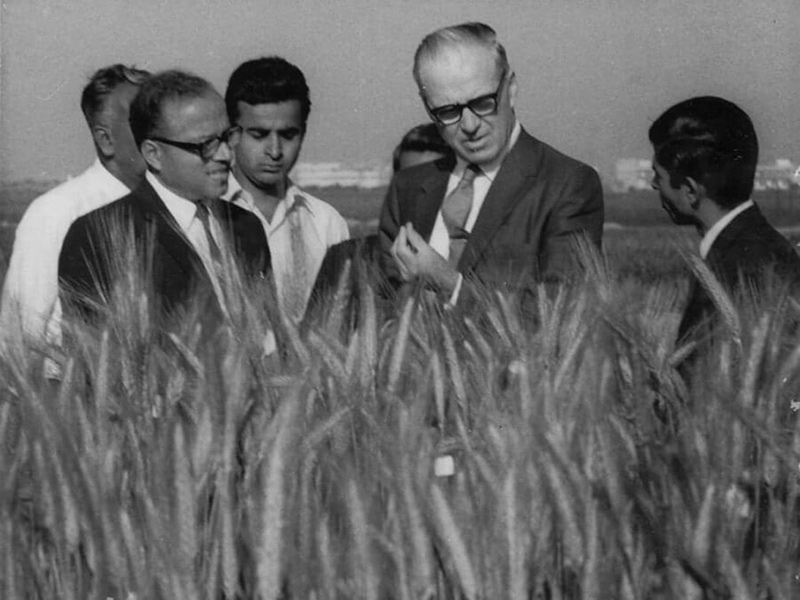
Green shoots of a revolution
Despite the poor first impressions, Swaminathan’s openness to scientific ideas resulted in extensive trials of Borlaug’s Mexican wheat. In 1963, the two men met again.
Swaminathan took Borlaug and his students on a five-week harvest-time tour of north India and the agri research institutions. “This time the two men hit it off. Borlaug discovered that the man whom he had taken for a time-server had one of the most brilliantly swift agricultural minds. And Swaminathan learned that what he had taken for [Borlaug’s] brusque condescension was a directness and simplicity that he thought almost child-like,” records Mann.
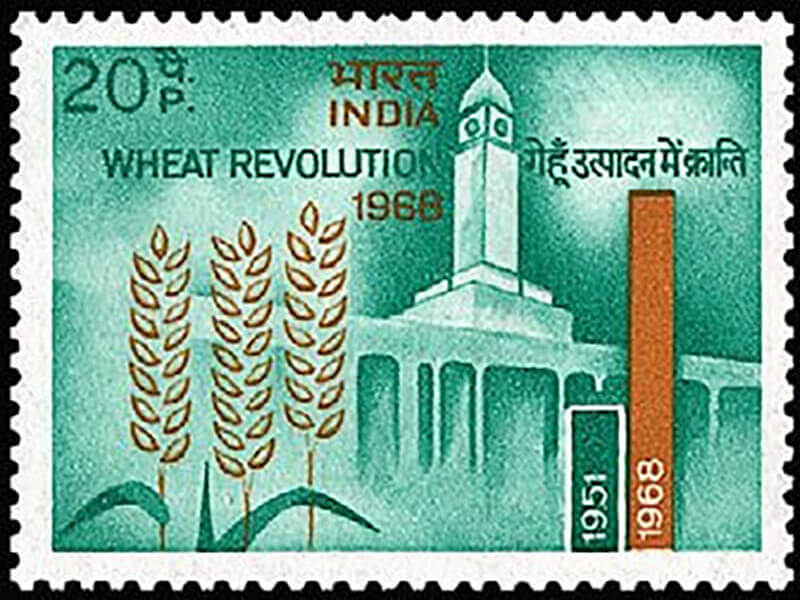
Impressed by Swaminathan’s work, Borlaug sent a consignment of a wide range of seed materials of his two Mexican dwarf wheat varieties, Sonora-64 and Lerma Rojo to India in the following months. The seeds when planted in IARI’s plots responded so well to fertilizers and irrigation that they produced almost three times more than conventional varieties without being afflicted by diseases and pests. Multi-location testing of these wheat varieties in the 1963–64 winter season attested to the potential success at hand.
The breakthrough stage of the Green Revolution had truly begun. Farmers who were introduced to the ‘package’ of high-yielding varieties of seeds, access to fertilizers and good irrigation reported sensational results. In 1964–65, Swaminathan organized 1000 national demonstrations in one-hectare plots in the fields of hundreds of small farmers. The government offered Rs 500 a hectare for the cost of seeds and essential inputs. The results were spectacular; every farmer in Punjab wanted the new wheat seeds but there wasn’t enough of it.
A new beginning
In May 1964, India’s first and longest serving Prime Minister Nehru died. He was replaced by Lal Bahadur Shastri, an Independence leader of impeccable credentials who had a firmer understanding of India’s agrarian reality. Swaminathan’s pleas for greater investment in agri R&D and the farm sector in general found more receptive ears.
Shastri appointed C Subramaniam, a politician from Coimbatore with progressive ideas and a technocratic approach to farming and economic management as the minister for food and agriculture. Subramaniam was the minister for steel in the Nehru cabinet and this new assignment was widely perceived as a political demotion.
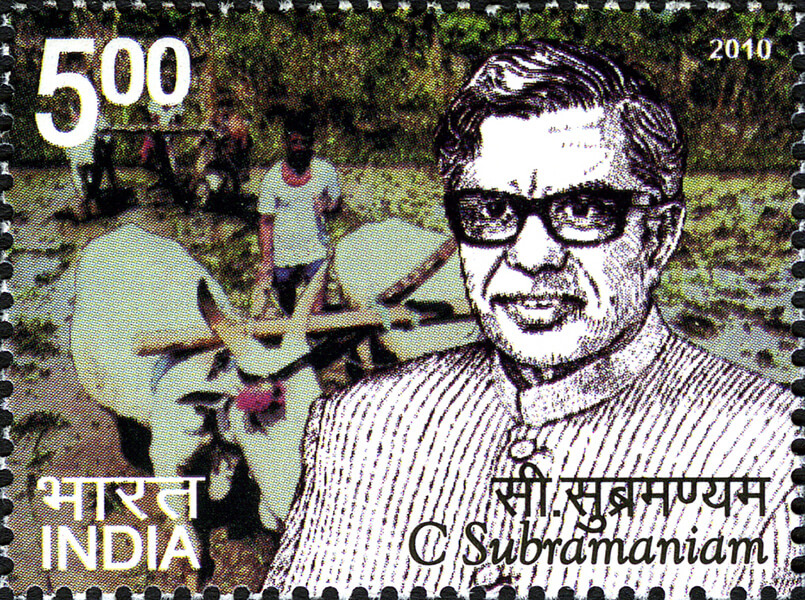
Shastri’s slogan ‘Jai Jawan Jai Kisan’, popular to this day, in effect signalled a departure from the Nehruvian course of prioritizing heavy industry over agriculture and national security.
Swaminathan’s suggestion to import 250 tonnes of Mexican semi-dwarf wheat to be planted on 3000 hectares was approved instantly. A bumper crop resulted. Based on this successful experience, Swaminathan and Borlaug pushed for the rapid adoption of Mexican wheat varieties in India, “Swaminathan the scientist became Swaminathan the promoter, undergoing the same transformation that Borlaug himself had earlier gone through in Mexico,” writes RD Iyer, Swaminathan’s biographer.
Even after the Shastri’s death in 1966, his successor Indira Gandhi, continued supporting the new farm programme unburdened by her father’s attachment to the heavy industry-led economic model. In 1968, the Green Revolution had started producing visible results. Wheat production jumped to 17 million tonnes from 12 million tonnes in a single year. “This increase was a revolutionary jump, not an evolutionary one,” says RD Iyer.
Blaming science
It is fashionable for environmentalists and activists to hold Swaminathan, Borlaug and the advances in science that led to the Green Revolution for all the crises of their imagination.
“Borlaug seldom replied directly, though the attacks stung. In private, he told friends that most of the criticism was sheer elitism. Somehow rich environmentalists in the West thought the world was better off if people in poor areas didn’t improve their lives. He had nothing against organic this or that but it was unrealistic to promote it as a solution to hunger in the world of 10 billion. And it was immoral to stand in the way of feeding hungry people,” writes Mann.
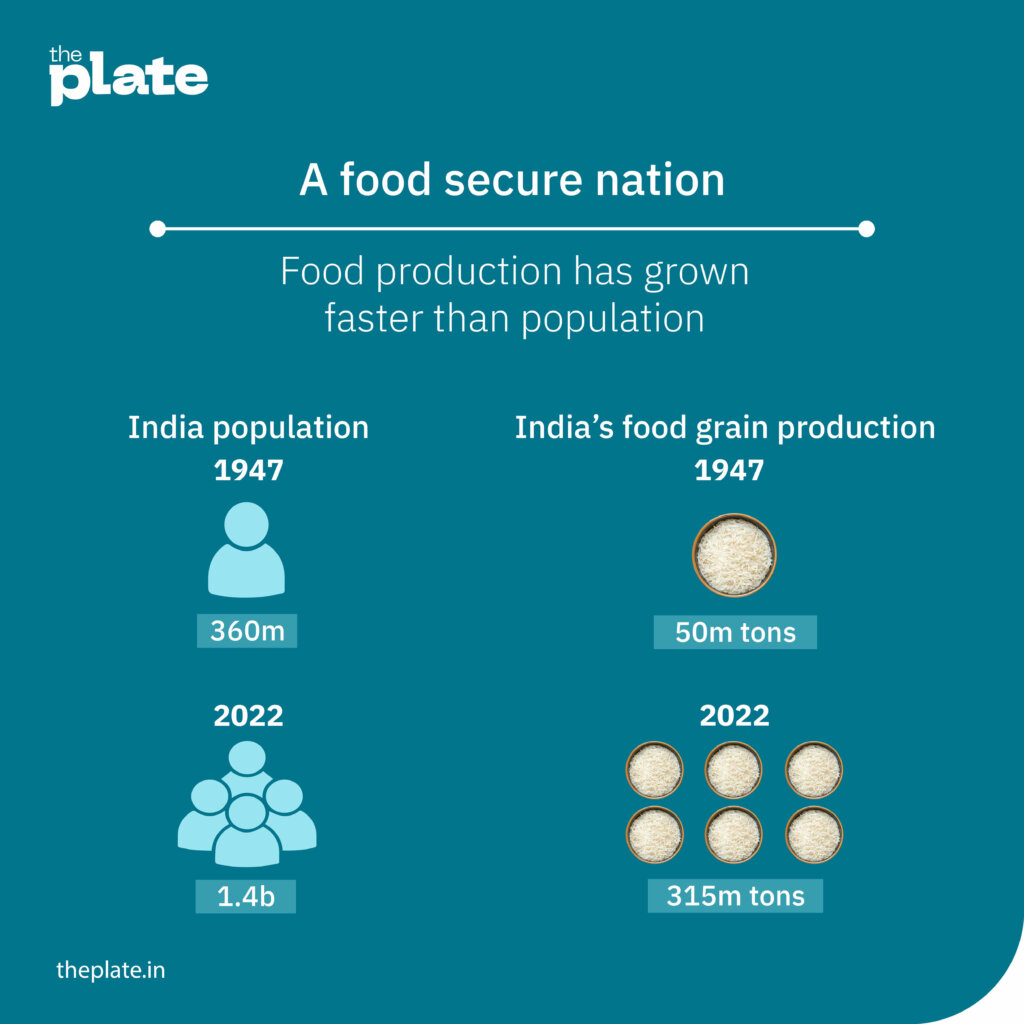
Borlaug may not have been too far off the mark. Such critiques, mostly put forth by the elites speaking with the benefit of hindsight and a full-stomach, are as bereft of nuance as India’s granaries in 1947. Addressing the Indian Science Congress at the Banaras Hindu University in 1968, when the Green Revolution’s footprint in India was marginal, Swaminathan said: “Exploitative agriculture offers great possibilities if carried out in a scientific manner, but poses great dangers if carried out with only an immediate profit or production motive. Intensive cultivation of land without conservation of soil fertility and soil structure would lead, ultimately, to the springing up of deserts. Irrigation without arrangements for proper drainage would result in soils getting alkaline or saline. Indiscriminate use of pesticides, fungicides and herbicides could cause adverse changes in biological balance and lead to an increase in the incidence of cancer and other diseases, through the toxic residues present in the grains or other edible parts. Unscientific tapping of groundwater will lead to the rapid exhaustion of this resource left to us through ages of natural farming. The rapid replacement of numerous locally adapted varieties with one-or-two high-yielding strains in large, contiguous areas would result in the spread of serious diseases capable of wiping out entire crops. The initiation of exploitative agriculture without a proper understanding of the various consequences of every one of the changes introduced into traditional agriculture, and without first building up a proper scientific and training base to sustain it, may only lead us, in the long run, to an era of agricultural disaster rather than one of agricultural prosperity.”
To hold our politicians, policymakers and corporations to account on matters as important as food and agriculture based on the scientific wisdom of Indian heroes such as MS Swaminathan would be a better tribute than a campaign to confer them with Bharat Ratna.
The 500-odd farmers of Gurha Kumawatan, a village in arid Rajasthan, are now millionaires thanks to polyhouse farming. Their hard work, innovation and unlimited ambition offers a path to prosperity for others in India.
Nice article. I read an article in Tamil on Nammazvar. the article says Dr.Swaminathan rightly chose fertiliser farming for
getting better yield to usher in green revolution in India.
Dear Sir/ Madam Brilliant Exposition and really a Short Treatise- well Researched Paper with so many important Agri tech details I never knew before. I sailed on ships from 1965 to 1975 which carried Food Grains . I can personally connect to Ship To Mouth as we navigated our ships from US Ports and Canada-esp Vancouver with GOVT Ob India Charters through FCI (MMTC) and under some link of PL 480 , WFP programs etc . As a Mariner I had no idea of what was the Govt Sale programes except the brief Telex we used to get of –” Load and Sail to Indian Port” a voyage from across USNP ,across the Pacific – China Seas, Malacca Straits to India usually 35 Days in those old slow ships–but we managed well . Every Full Cargo delivered Safely. One trip we had to take 42000tones of Wheat to Bangla desh from Vancouver after they got Independance – after the War.
Recalling the Agri scene from 1950s -in Madras, when I stood in Ration Ques for Rice and Wheat .
Also recall the slogan Rice less Day and One Meal a day to manage Food Shortages in 1960s . I salute Sri Sam Swaminathan, who I heard speak at MMA Chennai in 1980s . Salutations Sir . Yoiu may not get some Aw3ard but you will be in Hearts and Minds of all Indians, esp of my generation of 1945 Wallahs . Respects CaptTR ( retd)
Chennai
Feeding hungry people is one moto. Second important moto was to produce quality and sustainable supply. Ofcourse researcher,research work and implementation of the visionary work was of equal importance. Hats off to Great MS Swaminathan whose continuously working on the object and made it a subject of success.
Very good article and good biography I read today.
[…] Read the full story here […]